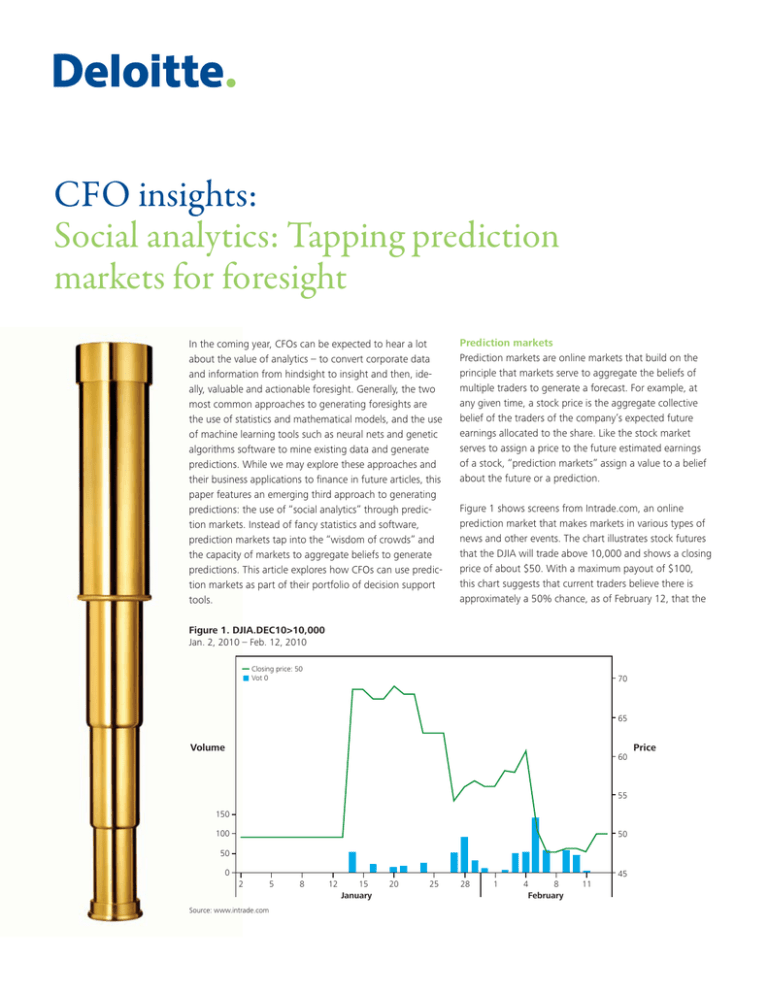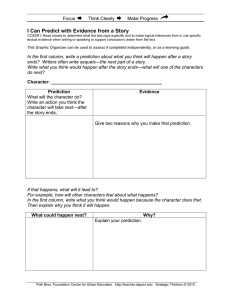
CFO insights:
Social analytics: Tapping prediction
markets for foresight
In the coming year, CFOs can be expected to hear a lot
about the value of analytics – to convert corporate data
and information from hindsight to insight and then, ideally, valuable and actionable foresight. Generally, the two
most common approaches to generating foresights are
the use of statistics and mathematical models, and the use
of machine learning tools such as neural nets and genetic
algorithms software to mine existing data and generate
predictions. While we may explore these approaches and
their business applications to finance in future articles, this
paper features an emerging third approach to generating
predictions: the use of “social analytics” through prediction markets. Instead of fancy statistics and software,
prediction markets tap into the “wisdom of crowds” and
the capacity of markets to aggregate beliefs to generate
predictions. This article explores how CFOs can use prediction markets as part of their portfolio of decision support
tools.
Prediction markets
Prediction markets are online markets that build on the
principle that markets serve to aggregate the beliefs of
multiple traders to generate a forecast. For example, at
any given time, a stock price is the aggregate collective
belief of the traders of the company’s expected future
earnings allocated to the share. Like the stock market
serves to assign a price to the future estimated earnings
of a stock, “prediction markets” assign a value to a belief
about the future or a prediction.
Figure 1 shows screens from Intrade.com, an online
prediction market that makes markets in various types of
news and other events. The chart illustrates stock futures
that the DJIA will trade above 10,000 and shows a closing
price of about $50. With a maximum payout of $100,
this chart suggests that current traders believe there is
approximately a 50% chance, as of February 12, that the
Figure 1. DJIA.DEC10>10,000
Jan. 2, 2010 – Feb. 12, 2010
Closing price: 50
Vot 0
70
65
Volume
Price
60
55
150
100
50
50
0
45
2
Source: www.intrade.com
5
8
12
15
January
20
25
28
1
4
8
February
11
Figure 2. DOW.CLOSE.2010<6500
Feb. 26, 2009 – Feb. 13, 2010
Closing price: 17
Vol:4
100
80
Volume
60
Price
40
300
20
200
100
0
Mar. 09 April
0
May
June
July
Aug.
Sept.
Oct.
Nov.
Dec.
Jan. 8
Feb
Source: www.intrade.com
DJIA will end the year above 10,000. Similarly, Figure 2
illustrates a 17% probability expectation that the Dow will
close below 6500. The direction of the latter chart suggests the markets fears of a melt down below 6500 have
progressively declined in the last year.
drops in value in April, it may be prudent to further investigate whether there are problems in meeting the scheduled
start date of the plant. This may be followed by policy
actions to remedy delays or to alert investors and analysts
about expect delays.
These simple examples illustrate three valued characteristics of prediction markets versus many other forecasting
approaches. First, the trading price of stocks on future
events, which pay out a $100 when the event occurs or
$0 otherwise, provides a reasonable estimate of what the
traders in aggregate believe to be the probability of the
event. Second, prediction markets allow dispersed sources
of information and insight to be aggregated through the
market process to generate a composite market forecast.
Effectively, one is able to tap into a vast pool of intelligence and information dispersed amongst many diverse
traders to generate a forecast. Third, market traders can
continuously adjust the price and hence the probability
of the event conditioned to the new market information.
This creates a dynamic forecasting and near real-time
application that attempts to incorporate all information amongst traders. Thus, dramatic shifts in price and
volume can trigger decision makers to further investigate
or respond to specific issues that seem to underlie price
changes. For example, if the price and trading in a stock
“New China Plant Begins Production in June” suddenly
How accurate are these markets? Academic studies show
that the performance of prediction markets versus polling
on election forecasts is as good as or better than polls.1
Reviews of various prediction markets, by Justin Wolfers and Eric Zitzewitz, also show that prediction markets
perform as well as or better than other forecasting
techniques.2 Prediction markets have also been used in
diverse corporate settings and generate useful forecasts to
motivate their continued use – but assessments compared
to other methods are generally rarely publicly available.
Nevertheless, the press to date suggests they are useful for
sales forecasting and to forecast the completion times of
various projects. Indeed these tools have been deployed at
companies like Google, Best Buy, Motorola, and Corning
for various forecasting applications.
While we want to tap into the “wisdom of crowds,”
the events of the Tulip mania to the South Seas Bubble
sometimes illustrate the “madness of mobs” in markets.
Therefore, market information and forecasts should always
be critically reviewed and evaluated.
How can CFOs use prediction markets
CFOs can use prediction markets to reduce uncertainty.
Begin by considering the greatest areas of uncertainty
that affect your organization. Is it the sales forecasts in a
particular business segment? Is it the differences in sales
across regions? Is it the cost of a critical resource such as
oil? Is it the timely completion of a particular project? Is it
uncertainly about whether a project will be within budget;
and the variance if it is not?
What should CFOs consider
The first issue CFOs should consider is the value of resolving a particular uncertainty. Can, for example, knowing the
delay of a project enable cost savings or other benefits?
Can having better sales forecasts enable the company to
confidently pay down debt? Rank-ordering uncertainties
that need to be resolved, based on the value of resolution, identifies a priority list of potential prediction market
applications.
For each of these types of questions we can generate prediction markets within an organization where the employees trade on different “prediction stocks.” The value of
this trading is that it creates valuable signals for management that include the probability of different outcomes. It
can alert management to take action to remedy potential
problems such as a project potentially going off track from
a timing and budget perspective.
The second issue to consider is whether prediction
markets are the right tool to address a particular uncertainty. If the item to be forecasted, or known drivers that
impact the forecast, or both have a time series of historical
data available, it may be easier to apply other forecasting techniques such as the use of statistics or machine
learning. These techniques do not require the participation
of many individuals in the process – unlike a prediction
market which requires many traders. Prediction markets
are especially suited to situations where there is sparse
data otherwise available that may be used to define a
forecasting model.
Typically, the most important forecasts to analysts and
investors are expected earnings per share. However, forecasting the next quarter or year’s earnings per share may
not necessarily be a good application of these markets.
A predictive market on that indicator could risk a large
group of insider participants having access to privileged
information and beliefs before analysts and public investors. This course could create a risk of insider trading or
possibly worse.
However, CFOs may use these markets to generate forecasts of variables that can potentially be utilized in other
forecasting models. Thus, a prediction market generating
sales forecasts in a region or business segment may provide useful input into broader earnings per share forecasting models. The other benefit CFOs can gain from these
markets is a sense of uncertainty and volatility in specific
variables that may motivate them to take steps to better
manage or reduce the uncertainty. These may include
entering into long term sales contracts to reduce sales or
price variability in a specific region.
The third issue to consider is the “cost” of prediction markets given that it is a social analytic approach. Prediction
markets require multiple participants, and the CFOs using
them require multiple traders be recruited and incentivized
to participate from within the firm. Fortunately, the traders
do not have to trade with real money, and the trading
of points that may then be converted to a reward, such
as a vacation or an iPod, seems to generate forecasts on
par with trading money. The true cost or benefit, in some
cases, is the transparency of such a market forecasting
system. It makes areas of uncertainty, and issues such as
projects going off track, more visible to a wide variety of
participants. Again, CFOs using these markets need to
decide if the organization desires and benefits from the
transparency that these markets drive.
The fourth issue to consider is the availability of the
right expertise to design and deploy these markets. The
technology is easy and widely available. The design of a
program with incentives, recruitment of participants, good
forecasting questions, and alignment to a company’s
culture may not be easy to achieve. While many prediction market vendors are probably too ready to sell you
their market and technology as a solution, what is really
important is their capacity to support the organizational
acceptance of the technology.
Conclusions
Prediction markets are emerging as a valuable forecasting tool in diverse application areas from sales forecasts
to project success. This social analytics strategy could
potentially help resolve a number of business uncertainties – especially where prior data may be sparse or the
situation is so unique that other forecasting tools are less
useful. While there are a number of design considerations
in these markets, the most critical is whether you want to
engage in having multiple participants share in a market
process to resolve the uncertainty. While the technology
for markets is easy to implement, aggregating a number
of traders and involving them in a market process to resolve uncertainty in an organization is more difficult. Thus,
the application of these methods to forecasting requires
broader leadership and an effective process for organizational buy-in.3
Primary contacts
Dr. Ajit Kambil
Global Research Director, CFO Program
Deloitte Services LP
akambil@deloitte.com
Deloitte’s CFO Program harnesses the breadth of
our capabilities to deliver forward-thinking
perspectives and fresh insights to help CFOs manage
the complexities of their role, drive more value in
their organization, and adapt to the changing
strategic shifts in the market.
For more information about Deloitte’s CFO Program,
please contact us at uscfoprogram@deloitte.com or visit
our website at www.deloitte.com/us/cfocenter.
Endnotes
1
Prediction Market Accuracy in the Long Run, by JE Berg, FD Nelson, and TA Rietz,
International Journal of Forecasting, Volume 24, Issue 2, April-June 2008, Pages
285-300.
2
Prediction Markets by Justin Wolfers and Eric Zitzewitz, Journal of Economic Perspectives, Volume 18, Number 2, Spring 2004 and Interpreting Prediction Market
Prices as Probabilities, Justin Wolfers and Eric Zitzewitz, Working Paper, January
2007.
3
Making Markets: How firms can Design and Profit from Online Markets and
Exchanges, chapters 3 and 6, Ajit Kambil and Eric van Heck, Harvard Business
School Press, June 2002, Winner 2004 Erasmus Research Institute in Management, Best Book Award.
This publication contains general information only and Deloitte is not, by means of this publication, rendering accounting, business, financial, investment, legal, tax, or other professional
advice or services. This publication is not a substitute for such professional advice or services, nor should it be used as a basis for any decision or action that may affect your business.
Before making any decision or taking any action that may affect your business, you should consult a qualified professional advisor.
Deloitte shall not be responsible for any loss sustained by any person who relies on this publication.
As used in this document, ‘Deloitte’ means Deloitte LLP (and its subsidiaries). Please see deloitte.com/us/about for a detailed description of the legal structure of Deloitte LLP and its
subsidiaries.
Copyright © 2010 Deloitte Development LLC. All rights reserved. Member of Deloitte Touche Tohmatsu.



